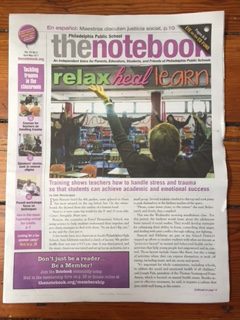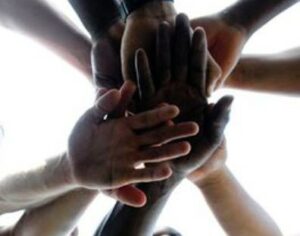The Inner Strength Teen Program just received some insightful coverage in the April 11th issue of The Notebook, Philadelphia’s Education weekly.
You can read the article Relax, Heal, Learn by Dale Mezzacappa @dalemezz in its original with comments and more on The Notebook’s coverage of Behavioral and Mental Health initiatives in the schools here. Images by Darryl Murphy of The Notebook. I encourage you to make your comments on The Notebook’s site and contribute to the public debate.
Read the reprint here:
Pam Bunyon f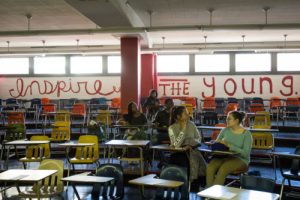 aced the 4th graders, some splayed in chairs but most arrayed on the rug before her. On the whiteboard, she showed them the outline of a human head.
aced the 4th graders, some splayed in chairs but most arrayed on the rug before her. On the whiteboard, she showed them the outline of a human head.
Next to it were some big words for the 9- and 10-year-olds: Cortex. Amygdala. Brain stem.
Bunyon, the counselor at Powel Elementary School, was using science to help students understand their impulses and give them strategies to deal with them. “So we don’t flip out,” as she and the class put it.
A few weeks later, in a classroom at South Philadelphia High School, Amy Edelstein watched a clutch of laconic 9th graders shuffle their way into a 9:13 a.m. class. It was third period, and the music classroom was tiered and set up for an orchestra, not a small group. Several students climbed to the top and took pains to park themselves at the farthest reaches of the space.
“Please, come down closer, to the center,” she said. Reluctantly and slowly, they complied.
This was the Wednesday morning mindfulness class. For this period, the students would learn about the adolescent brain instead of social studies. They would develop strategies for enhancing their ability to focus, controlling their anger, and dealing with peer conflict through talking, not fighting.
Bunyon and Edelstein are part of the School District’s stepped-up efforts to insulate students with what are known as “protective factors” in mental and behavioral health circles – activities that help young people feel empowered and in control. Those factors include classes like these, but also a range of activities where they can express themselves or work off energy, including music and art, recess and sports.
“It’s important for whole communities, including schools, to address the social and emotional health of all children,” said Joseph Pyle, president of the Thomas Scattergood Foundation, which is focused on mental health issues. Besides access to effective treatment, he said, it requires a culture that puts child well-being at the center.
“Since children spend so much time in schools, schools play an important role,” he said. “Teachers and other school staff … need to have strategies and tools to accomplish this goal [and] address stress and adversity.”
That is what Bunyon realized as a District counselor. She spent several years at Feltonville Middle School, where almost all the students live in poverty and where there is a large immigrant community. Stress was rampant.
“I was doing crisis management all the time,” she said.
She was among those laid off in 2013 when the District decimated its counseling staff in reaction to slashed state aid and the end of federal stimulus funds.
But the layoff was the impetus for her to join a group of counselors seeking to upgrade their training and to attend workshops for educators run by the Institute for Family Professionals. She said those workshops changed her whole approach to teaching.
Bunyon took classes on anger, understanding the teen brain, discipline strategies, and trauma. All imparted a trauma-sensitive approach and were driven by brain science.
When Bunyon and most of her colleagues were hired back in 2014, the District started offering those workshops through the institute.
“We really ate them up and got certified as trauma professionals,” said Bunyon, who became a trainer herself.
“I use what I learned in everything I do,” she said. “It totally transformed the way I deal with children.”
Before the training, she said, when children were upset, she looked at them cognitively and tried to talk to them about what happened. Now, she concentrates on what’s happening in their brain, having learned that trauma triggers “fight or flight” reactions. Talking won’t work.
“Whenever they’re in an elevated brain state, they don’t have access to their cognitive abilities,” she said..”We have to meet them where they are and make sure they understand they are safe so they have access to cognition.”
Once she used this strategy after chasing a Feltonville student who was so traumatized that he ran down the street instead of going into the school after getting off the bus.
“He was a flight kid,” she said. “I had to come up with ways for him to escape while still being in the building.”
She discovered that he liked to read, so she gave him books. He devoured the Percy Jackson adventure series, sometimes while nestled inside a big toy chest in her office.
“Before I was really trained, I would have been sending him to the crisis center at Einstein,” she said. The boy still needed help to function in school and attend classes regularly, she said, but this was a start.
“As a society, we have to figure out the next steps, how we educate these kids who need all these extra supports,” she said.
In schools, “there are a whole lot of things we could be doing to keep children from getting so triggered.”
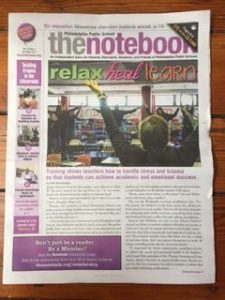
Tools to as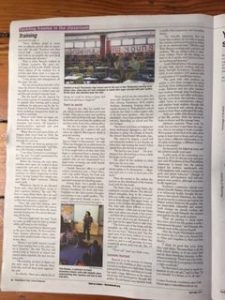 sist
sist
Bunyon’s tiny office has sparkle bottles, which children make from used water bottles. They put in water and sparkling confetti and seal them with tape. Shaking the bottles and watching the sparkles roil and then settle down has a calming effect.
She also has fidgets. Some are m
ade for that purpose, like a squeeze ball, and others are adapted, like a pencil, which is great for twisting.
“When you are twisting your hair, that is a ‘fidget’ at that moment,” she said. “There are strategies we as adults know to use sometimes. We do them unconsciously. If we taught kids to do that, then they begin to understand that’s a strategy they can use to alleviate their anxiety. Even students who are not ‘traumatized’ in a larger sense of trauma can really benefit from these strategies.”
Outside Bunyon’s office is a small cubicle transformed into a Peace Place, with a big stuffed Winnie the Pooh and a poster on the wall displaying student-generated strategies for handling anger.
Among them: Use a sparkle bottle. Meditate. Tell the upper brain to think. Practice breathing. Lie down and relax. Students can also draw positive thoughts and pictures or use a small sandbox. The cubicle’s glass panel, though, is gone – a young child pushed his hand through it.
Music and art are also important, Bunyon said. Students who like to draw find that calming. Sometimes, she’ll employ rhythmic drumming. Keeping these as regular features in Philadelphia’s school curricula has been a roller-coaster ride, as art and music teachers – who are not mandated – have been reduced and then restored, depending on school and District budgets.
Her classes now focus on helping students understand themselves and their reactions to stress. On a Friday in March, she visited Chris Powers’ 4th-grade class.
She started by ringing a small bell and asking the students to put thumbs up when they stop hearing the sound. A boy named Ezra was the last to respond.
“He had his eyes closed. … I’m wondering if that allowed him to focus a little bit longer on the sound.”
She asked all the students to close their eyes the next time.
“Part of mindfulness is that there are always going to be distractions. … Shutting your eyes is a way to focus just a bit more.”
Then she turned to the outline she had put on the whiteboard of the human head with the big words.
The brain stem, or lower brain, she explained, controls reflexes. The almond-shaped amygdala, deep in the temporal lobe, is a traffic cop, whose job is to protect us from danger. The upper brain, or cortex, is the thinker, the problem-solver. The class talks about reflexes or involuntary actions – what part of your brain takes over when you touch a hot stove? – and then about persistence and not giving up, even when you get frustrated, to give time for the upper brain to take over.
“The lower part of the brain and the amygdala are fully functional from the day you are born,” Bunyon said, “but the upper part of the brain, believe it or not, the upper part of the brain is where the cortex is, and it is still growing. It is not completely grown until you are, like, 25 years old.”
“That’s sad,” pipes up a little voice.
Lessons learned
Bunyon is in the process of training teachers in the building so they can better react to students on a daily basis. Powel principal Kim Ellerbee said Bunyon’s work has made a huge difference at the school, which has 300 kindergarten through 4th graders. Its catchment area includes both a middle-class community and a homeless shelter.
“It’s critically important that we know that students are not able to access the content teachers are focused on if they are in an emotional state,” Ellerbee said. With Bunyon working with teachers and students, “We are seeing a shift in classroom culture. These are the things we need to do to set the reset button to focus on teaching and learning.”
South Philadelphia is the most recent of nine high schools working with the Inner Strength Foundation. Founded in 2014, it now reaches 1,200 students with a curriculum of 12 mindfulness lessons.
The goals with older students are similar: to give them strategies for coping and help them understand how the brain works. Edelstein and her other teachers lead students through deep breathing exercises, meditation and other techniques. But the curriculum also includes a lesson called “teens in contemporary culture,” and another leads students through 600 years of historical and cultural developments to help them understand life today.
And, not unlike what Bunyon teaches her 4th graders, there are lessons in brain evolution and, specifically, the teenage brain.
Edelstein cautions: These tools “do work, but you have to put them into practice, they’re not going to work overnight. We’re going to learn how to be calm, we’re going to learn how to focus, and we’re going to learn a different relationship to our thoughts and feelings, a different relationship to our minds.”
At one point, the fidgeting stops, and she achieves nearly total quiet in the room.
A pilot study of the curriculum conducted in 2015-16 did pre-tests and post-tests with 98 students in four Philadelphia classrooms. It found that the sessions helped the students significantly with “self-regulation with respect to long-term goals and global behavior.” Changes in short-term self-regulation and self-compassion were positive, although not statistically significant.
Southern’s community schools coordinator, Janelle Harper, whose background is in behavioral health, brought the program to the school. Elsewhere, the classes are given mostly to juniors and seniors, but Harper wanted them for 9th graders, who are particularly vulnerable and stressed. Little changes are already evident, said Harper and Crystal Edwards, the assistant principal for the 9th-grade academy.
“They are pausing to think before they react, which for 9th graders is really a monumental decision,” said Edwards, who attends most of the sessions herself.
After the South Philadelphia session, the third in the 12-class cycle, friends Haley Alisio and Angelina La Barr said they liked it.
“I think it’s good that we’re doing this,” said Alisio, “because there is all this little school drama, so if you come here and do these breathing exercises, it, like, relaxes everybody. There’s not a lot of tension, so everybody is not going to be trying to fight everybody.”
“In this school you need as much relaxation as you can get,” said La Barr. “It is so stressful. It is drama, so it’s all right.”

